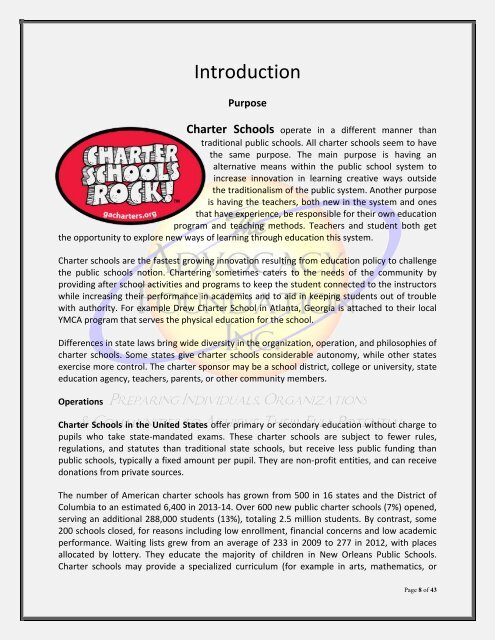The 21st Century Charter Schools Initiative
The 21st Century Charter Schools Initiative
The 21st Century Charter Schools Initiative
Create successful ePaper yourself
Turn your PDF publications into a flip-book with our unique Google optimized e-Paper software.
Introduction<br />
Purpose<br />
<strong>Charter</strong> <strong>Schools</strong> operate in a different manner than<br />
traditional public schools. All charter schools seem to have<br />
the same purpose. <strong>The</strong> main purpose is having an<br />
alternative means within the public school system to<br />
increase innovation in learning creative ways outside<br />
the traditionalism of the public system. Another purpose<br />
is having the teachers, both new in the system and ones<br />
that have experience, be responsible for their own education<br />
program and teaching methods. Teachers and student both get<br />
the opportunity to explore new ways of learning through education this system.<br />
<strong>Charter</strong> schools are the fastest growing innovation resulting from education policy to challenge<br />
the public schools notion. <strong>Charter</strong>ing sometimes caters to the needs of the community by<br />
providing after school activities and programs to keep the student connected to the instructors<br />
while increasing their performance in academics and to aid in keeping students out of trouble<br />
with authority. For example Drew <strong>Charter</strong> School in Atlanta, Georgia is attached to their local<br />
YMCA program that serves the physical education for the school.<br />
Differences in state laws bring wide diversity in the organization, operation, and philosophies of<br />
charter schools. Some states give charter schools considerable autonomy, while other states<br />
exercise more control. <strong>The</strong> charter sponsor may be a school district, college or university, state<br />
education agency, teachers, parents, or other community members.<br />
Operations<br />
<strong>Charter</strong> <strong>Schools</strong> in the United States offer primary or secondary education without charge to<br />
pupils who take state-mandated exams. <strong>The</strong>se charter schools are subject to fewer rules,<br />
regulations, and statutes than traditional state schools, but receive less public funding than<br />
public schools, typically a fixed amount per pupil. <strong>The</strong>y are non-profit entities, and can receive<br />
donations from private sources.<br />
<strong>The</strong> number of American charter schools has grown from 500 in 16 states and the District of<br />
Columbia to an estimated 6,400 in 2013-14. Over 600 new public charter schools (7%) opened,<br />
serving an additional 288,000 students (13%), totaling 2.5 million students. By contrast, some<br />
200 schools closed, for reasons including low enrollment, financial concerns and low academic<br />
performance. Waiting lists grew from an average of 233 in 2009 to 277 in 2012, with places<br />
allocated by lottery. <strong>The</strong>y educate the majority of children in New Orleans Public <strong>Schools</strong>.<br />
<strong>Charter</strong> schools may provide a specialized curriculum (for example in arts, mathematics, or<br />
Page 8 of 43

















